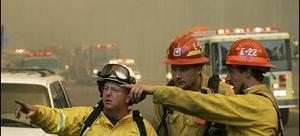
|
| ©AP Photo/Ben Margot |
| Firefighters on Highway 89 discuss how best to deal with the Angora fire after it jumped firelines |
MEYERS, Calif. - Firefighters trying to tame a raging wildfire that has destroyed some 200 homes near Lake Tahoe Tuesday suffered a setback when the blaze jumped a fireline, forcing a new round of evacuations, authorities said.
Firefighters were working to protect a development outside South Lake Tahoe when the blaze expanded, prompting the evacuation of a 300-home subdivision. About 2,000 people evacuated, according to South Lake Tahoe Police Lt. Martin Hale.
Authorities also issued a voluntary evacuation order for a pricey waterfront subdivision on the lake, officials said.
"It's a fairly populated area," said U.S. Forest Service spokesman Tim Evans. "That certainly is not good news for our firefighting efforts here."
The flare-up is about three miles from where the fire started Sunday near the south end of Lake Tahoe. By Tuesday afternoon, the blaze had consumed more than 2,700 acres _ about 4.2 square miles _ and was about 40 percent contained, fire officials said.
Officials said the blaze jumped the fireline because firefighters set a backfire as part of their efforts to keep the main blaze from reaching more houses. When the wind picked up, embers crossed the fireline. Previously, firefighters had been able to contain the small spot fires that erupted.
The blaze moved so quickly that two firefighters were forced to deploy the emergency shelters firefighters carry to protect themselves during burnovers as a last resort, said Chuck Dickson, a U.S. Forest Service spokesman. They managed to walk away uninjured, he said.
The danger to homes had diminished overnight as firefighters got a badly needed advantage on the inferno. But it was still burning throughout the day along rugged, uninhabited slopes and authorities had cautioned that strong winds forecast to arrive Wednesday could fan the flames.
Earlier in the day, other families whose homes were in the path of the wildfire returned to their property, finding some houses reduced to charred ruins and others largely unscathed, except for the odor of smoke and a blanket of ash.
In the most heavily damaged neighborhoods, firefighters doused pockets of lingering flames. Smoke hung thick over blackened piles of rubble that were once homes to nurses, police officers and teachers.
"I didn't save hardly anything in the house," said retired firefighter John Hartzell, who lost his home of 20 years. Along with his wife, adult son and a daughter, he sorted through the rubble in search of any mementos.
"I got out with the clothes on my back, my fire coat and my helmet," he said.
Elsewhere, a beautiful home stood nearly untouched, even though all the sod in its yard had burned.
"It picks and chooses," said Lynn Cisl, whose home along the edge of the most damaged area also survived. "It's sort of like a disease. It's devastating."
Investigators determined that the fire began near Seneca Pond, an area popular with runners and teenagers in this resort area along the California-Nevada state line. They also said they were close to identifying its cause. An announcement on that was expected later Tuesday.
Authorities have said they believe the fire was caused by some kind of human activity, but U.S Forest Service officials said there was no indication it was intentionally set.
The forest here was so dry that a discarded cigarette butt or match could easily have ignited the fire, Forest Service spokeswoman Beth Brady said. The area was also dotted with the remnants of illegal campfires, she said.
Experts have said California and the rest of the West are entering what could be a long and dangerous fire season after one of the region's driest winters on record. They warn that years of logging, development and forest mismanagement have left the Tahoe area particularly vulnerable to catastrophic wildfires.
"Lake Tahoe Basin is probably an extreme example, but very similar conditions exist throughout the Sierra Nevada," Forest Service spokesman Matt Mathes said. "It can happen literally anywhere at any moment."
Concerned about looting, dozens of sheriff's deputies and California Highway Patrol officers roamed the burned neighborhoods, ensuring that only those who lived in the area were allowed in. Cars lined up to pass through an elaborate checkpoint where each vehicle's window was marked with white shoe polish to designate the street number of the home it was allowed to visit.
"It was eerie and awkward. You could see the expressions on everyone's face," said Lindsey Douglass, 22, after she made her way through the line of more than 30 waiting cars.
Concerns about downed power lines and other hazards forced some homeowners to delay their return until later this week.
___
Associated Press writers Aaron C. Davis, Brendan Riley, Juliana Barbassa, Don Thompson and Marcus Wohlsen contributed to this report.



Reader Comments
to our Newsletter